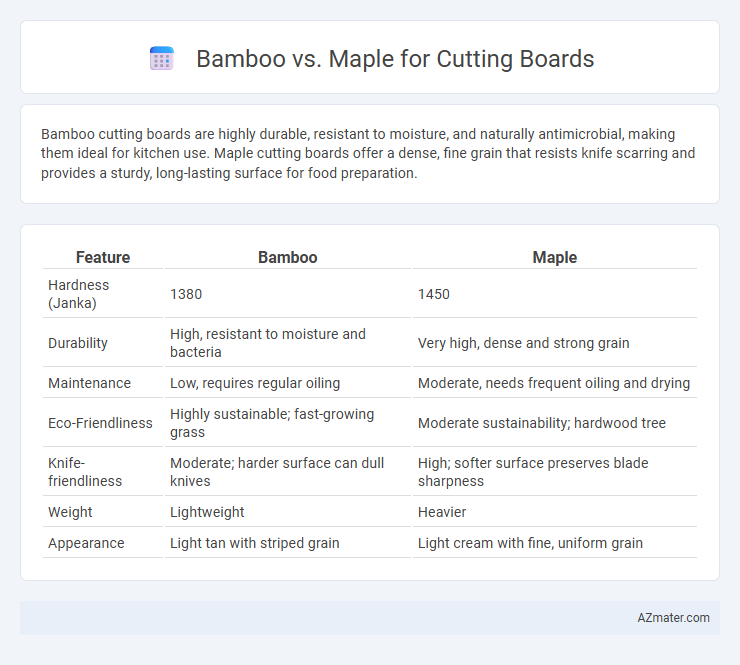Bamboo cutting boards are highly durable, resistant to moisture, and naturally antimicrobial, making them ideal for kitchen use. Maple cutting boards offer a dense, fine grain that resists knife scarring and provides a sturdy, long-lasting surface for food preparation.
Table of Comparison
| Feature | Bamboo | Maple |
|---|---|---|
| Hardness (Janka) | 1380 | 1450 |
| Durability | High, resistant to moisture and bacteria | Very high, dense and strong grain |
| Maintenance | Low, requires regular oiling | Moderate, needs frequent oiling and drying |
| Eco-Friendliness | Highly sustainable; fast-growing grass | Moderate sustainability; hardwood tree |
| Knife-friendliness | Moderate; harder surface can dull knives | High; softer surface preserves blade sharpness |
| Weight | Lightweight | Heavier |
| Appearance | Light tan with striped grain | Light cream with fine, uniform grain |
Introduction: Bamboo vs Maple Cutting Boards
Bamboo cutting boards are known for their sustainability, hardness, and natural antimicrobial properties, making them a popular eco-friendly choice for kitchens. Maple cutting boards, prized for their durability and fine grain, provide a smooth surface that resists knife marks and maintains sharpness. Both materials offer unique benefits in terms of maintenance, longevity, and food safety, with bamboo often being lighter and more affordable, while maple provides a classic, sturdy feel favored by many chefs.
Material Overview: Bamboo and Maple Explained
Bamboo cutting boards are crafted from fast-growing grass fibers, offering a lightweight, eco-friendly, and highly durable surface resistant to knife scarring and moisture absorption. Maple cutting boards, made from dense hardwood, provide a firm, self-healing surface that is less porous and naturally antibacterial, making them ideal for heavy-duty kitchen use. Both materials require proper care to maintain longevity, with bamboo excelling in sustainability and maple favored for its traditional hardness and resilience.
Durability and Longevity Comparison
Bamboo cutting boards exhibit exceptional durability due to their dense, fiber-based structure, resisting knife marks and warping over time. Maple boards, made from hardwood, offer strong shock absorption and maintain a smooth surface, though they may show wear faster than bamboo when subjected to heavy use. Both materials provide long-lasting performance, but bamboo typically outlasts maple in terms of resistance to moisture and daily wear.
Knife Friendliness: Which Is Gentler?
Bamboo cutting boards are generally less knife-friendly than maple due to their harder, more brittle fibers, which can cause blades to dull faster. Maple, a hardwood with a tight grain structure, provides a gentler surface that preserves knife sharpness longer and reduces the need for frequent sharpening. Choosing maple enhances long-term knife performance, making it a preferred option for those prioritizing blade preservation.
Maintenance and Care Requirements
Bamboo cutting boards are highly durable and resistant to moisture, requiring regular oiling with food-grade mineral oil to maintain their natural water-repellent properties and prevent cracking. Maple cutting boards demand more frequent oiling and sanding due to their softer wood fibers, which are prone to knife marks and moisture absorption, increasing the risk of warping and bacterial growth. Both materials benefit from thorough hand washing and drying immediately after use, but bamboo boards generally offer lower long-term maintenance due to their dense, naturally antimicrobial surface.
Environmental Impact and Sustainability
Bamboo cutting boards offer superior environmental benefits due to bamboo's rapid growth rate and renewability, requiring fewer resources and less time to mature compared to maple. Maple, a hardwood, grows much slower and its harvesting can contribute to deforestation if not sustainably managed. Choosing bamboo supports sustainable supply chains and reduces carbon footprint, making it a more eco-friendly option for cutting boards.
Hygiene and Bacterial Resistance
Bamboo cutting boards exhibit superior bacterial resistance due to their dense, non-porous structure and natural antimicrobial properties, which inhibit bacterial growth more effectively than maple. Maple's closed-grain hardwood surface is also hygienic but tends to absorb moisture over time, potentially harboring bacteria if not properly maintained. Regular cleaning and oiling are essential for both materials to ensure long-lasting hygiene and bacterial resistance.
Aesthetic Appeal and Design Options
Bamboo cutting boards offer a sleek, modern aesthetic with a consistent light color and fine grain pattern that complements minimalist kitchen designs. Maple cutting boards feature a classic, warm tone with natural variations and rich grain patterns that suit traditional or rustic decor styles. Both materials provide versatile design options, but bamboo's uniform texture allows for more contemporary, geometric shapes while maple's durability supports intricate edge detailing and end-grain construction.
Cost Analysis: Bamboo vs Maple
Bamboo cutting boards typically cost 20-30% less than maple boards due to bamboo's rapid growth and lower production expenses. Maple, valued for its durability and tight grain, commands higher prices averaging $30-$80 compared to bamboo's $20-$60 for similar sizes. Cost-effectiveness of bamboo makes it a preferred choice for budget-conscious consumers without significantly compromising quality.
Final Verdict: Which Cutting Board Should You Choose?
Bamboo cutting boards offer a hard, durable surface that's naturally antimicrobial and resistant to knife scars, making them ideal for heavy use and easy maintenance. Maple boards provide a tight grain structure that is gentle on knife edges, reducing dulling over time, and are prized for their aesthetic appeal and longevity with proper care. Choosing between bamboo and maple depends on your priority for durability and eco-friendliness versus a smoother surface that preserves your knives, with bamboo favored for sustainability and maple preferred for traditional craftsmanship.

Infographic: Bamboo vs Maple for Cutting Board
 azmater.com
azmater.com